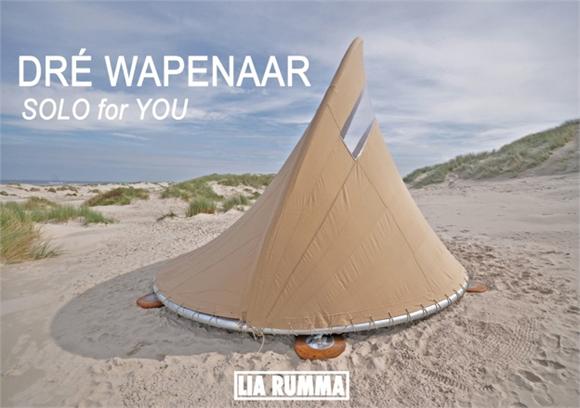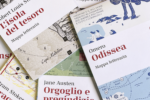Dré Wapenaar – Solo for you

La galleria Lia Rumma di Milano presenta un concerto/performance che vede come protagonisti l’artista olandese Dré Wapenaar e la stessa Lia Rumma.
Comunicato stampa
Il 16 novembre, alle ore 19, la galleria Lia Rumma di Milano presenta un concerto/performance che vede come protagonisti l'artista olandese Dré Wapenaar e la stessa Lia Rumma. Nel suo nuovo padiglione dedicato allo strumento musicale, e denominato appunto SOLO for YOU Piano Pavilion, Wapenaar eseguirà CANTO OSTINATO di Simeon ten Holt e SONG OF RELEASE di Joep Franssens. Fruitore unico della totalizzante esperienza acustica sarà Lia Rumma, che assisterà alla performance dell'artista/pianista seduta sul divano predisposto all'interno del padiglione. Due videocamere riprenderanno il tessuto di sguardi e di parole che si stabiliranno tra esecutore ed ascoltatore nello spazio della tenda, nonché il dettaglio delle mani del pianista che si muovono sulla tastiera, proiettando le immagini ingigantite all’esterno, per il pubblico presente al piano terra della galleria. Si tratta del terzo padiglione dedicato dall’artista al pianoforte ed alla esecuzione e fruizione della musica dal vivo. Il SOLO for YOU Piano Pavilion è dedicato in special modo, come già il Four Grand Piano Pavilion - per 200 spettatori del 2004 - all'esecuzione della musica di Simeon Ten Holt, che ha composto una serie di brani per 4 pianoforti, eseguibili anche da un solo strumento. I due padiglioni di Wapenaar, sono in qualche modo una traduzione scultorea della musica del compositore olandese: “descriverei la sua musica come dotata di elementi armonici e lirici con un'influenza minimalista. In termini musicali ciò si definisce come ‘spazio’; il tempo è contratto ed espanso, rallentato e reso più veloce”, afferma lo scultore/musicista in un intervento alla Design Conference di Aspen, Colorado, nel 2001. La forma e la geometria dell'involucro di SOLO for YOU Piano Pavilion sono concepite per accompagnare l'andamento del pianoforte a coda e quindi per concentrare, amplificare e far rimbalzare il suono intorno all'unico ascoltatore. Si tratta dell’esaltazione dell’esperienza sensoriale del singolo ascoltatore, che fa eseguire la musica a richiesta, e solo per sè. Impiegando i materiali, le logiche d'uso e i procedimenti produttivi dell'architettura e del design, Wapenaar conferisce forma scultorea all'ideale didattico-sociale del Bauhaus del "teatro totale", realizzatosi in maniera esemplare solo nell'architettura della Filarmonica di Scharoun a Berlino negli anni '60. Non a caso, l’artista definisce "total sculptures" i suoi “padiglioni”, in cui il pubblico posto al centro non è spettatore, ma parte dell'azione performativa. Scultura, architettura - anche la luce naturale cade dall'alto in questo nuovo padiglione - design ed arte performativa si intrecciano e si confondono in questo nuovo lavoro dell'artista di Rotterdam.
"A casa c'era un piano ... ho suonato il piano per tutta la mia vita, fino a due ore al giorno".
La galleria Lia Rumma collaborerà con la Milano Civica Scuola di Musica di Villa Simonetta, in via Stilicone, per l'esecuzione di un concerto di musica da camera in dicembre all'interno del padiglione.
Dré Wapenaar ha partecipato a mostre di gruppo come: Parasite Paradise, Utrecht (2003); Puddles, Gallery Surge, Tokyo (2003); New Hotels for Global Nomads, Cooper-Hewitt (2005); Safe, MoMA; Less, PAC Milano e Metropolitanscape, Palazzo Cavour, Torino (2006); Estuaire Biennial Nantes, (2007); Design Camp, Triennale di Milano (2009); Habitat effimeri, Ministero per l’Abitare, Madrid 2011 e personali presso: Museum Boijmans van Beuningen (2001); MassMoCA (2004); Due retrospettive gli sono state dedicate dallo Chabot Museum (2006) e dalla Kunsthal di Rotterdam. Nel 2007 il MassMoca gli commissiona un padiglione permanente, mentre nel 2011 l’artista progetta e realizza in officina un ponte, il Bike Bridge Pavilion a Wijhe (NL) frutto della vincita di un concorso. I suoi padiglioni per la musica sono utilizzati regolarmente per festival musicali come il Boulevard Den Bosch, dove l’artista è stato invitato anche come musicista.
-----------------
On November 16th at 7.00 pm, the Lia Rumma Gallery in Milan will present a concert/performance featuring the Dutch artist Dré Wapenaar and Lia Rumma herself. In his new pavilion devoted to the musical instrument, and named SOLO for YOU Piano Pavilion, Wapenaar will play CANTO OSTINATO by Simeon ten Holt and SONG OF RELEASE by Joep Franssens. The only person to appreciate the all-absorbing acoustic experience will be Lia Rumma who will listen to the performance of the artist/pianist seated on a sofa within the pavilion. The video cameras will capture the fabric of expressions and words that will be established between performer and listener in the tent, as well as the details of the pianist’s hands as they move on the keyboard, projecting the magnified images to the outside world, in this case the public on the ground floor of the gallery.
This is the third pavilion that the artist has devoted to the piano and the performance and enjoyment of live music. Like the Four Grand Piano Pavilion – designed in 2004 to hold an audience of 200 spectators -, the SOLO for YOU Piano Pavilion is specially devoted to the performance of music by Simeon Ten Holt who composed a series of pieces for 4 pianos which can also be played on just one instrument. Wapenaar’s two pavilions are, in a sense, a sculptural translation of the music of the Dutch composer. “I would describe his music as endowed with harmonic and lyrical elements with a minimalist influence. In musical terms, this can be defined as ‘space’; time is contracted and expanded, slowed down and made to go faster”, stated the sculptor/musician in a speech given at the Design Conference in Aspen, Colorado in 2001.
The form and geometry of the shell in the SOLO for YOU Piano Pavilion are designed to accompany the modulation of the grand piano and therefore to concentrate and amplify the sound, making it reverberate around a single listener. It exalts the sensorial experience of the single listener who has music performed on request and exclusively for him/herself.
By employing the materials, underlying logic and production procedures of architecture and design, Wapenaar gives sculptural form to the Bauhaus social ideal of “total theatre” which was put into practice, in an exemplary manner, in the Berlin Philharmonic Hall built by Hans Scharoun in the sixties. Indeed, the artist defines his “pavilions” as "total sculptures" where the public in the centre are not spectators but part of the performance. Sculpture, architecture – even the natural light falls from above in this new pavilion –design and art all intertwine and merge in this new work by the Rotterdam-based artist.
"At home there was a piano…I have played the piano all my life, often for up to two hours a day”.
The Lia Rumma Gallery will collaborate with the “Milano Civica Scuola di Musica” of Villa Simonetta in via Stilicone, Milan to hold a concert of chamber music in the pavilion in December.
Dré Wapenaar has taken part in various group shows such as the following: Parasite Paradise, Utrecht (2003); Puddles, Gallery Surge, Tokyo (2003); New Hotels for Global Nomads, Cooper-Hewitt (2005); Safe, MoMA; Less, PAC Milan and Metropolitanscape, Palazzo Cavour, Turin (2006); Estuaire Biennial, Nantes, (2007); Design Camp, Milan Trienniale (2009); Ephemeral Habitat, Ministry for Housing, Madrid 2011, and solo shows at Museum Boijmans van Beuningen (2001) and MassMoCA (2004). Two retrospectives were devoted to his work at the Chabot Museum (2006) and the Kunsthal in Rotterdam. In 2007 MassMoca commissioned the artist to create a permanent pavilion, while in 2011 the artist designed and built a bridge in his workshop, the Bike Bridge Pavilion at Wijhe (NL), the result of winning a competition. His pavilions for music are regularly used for music festivals such as the Boulevard Den Bosch where the artist was also invited as a musician.



